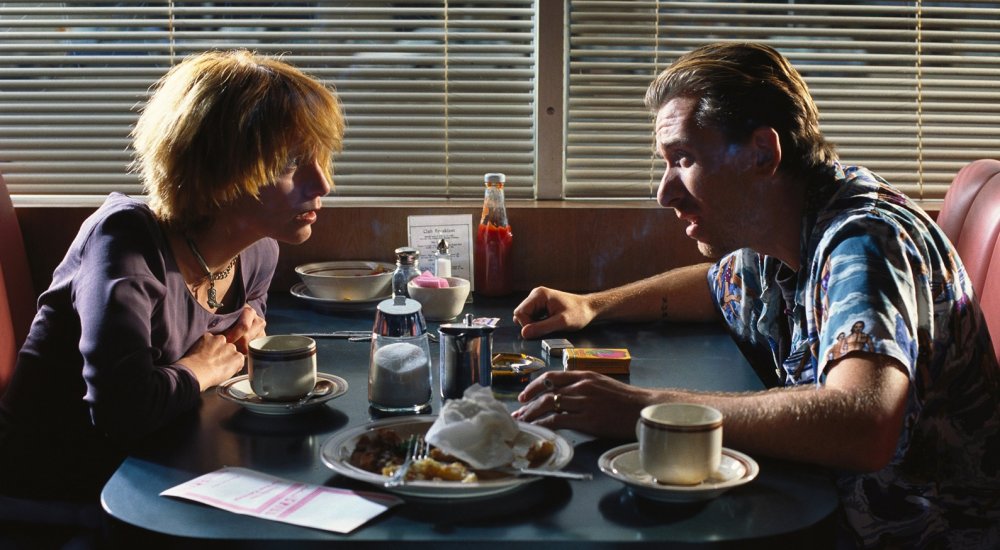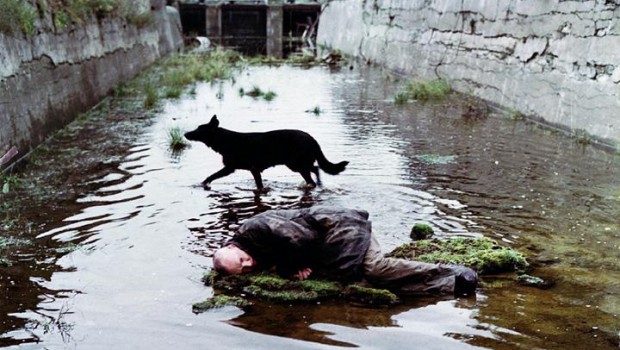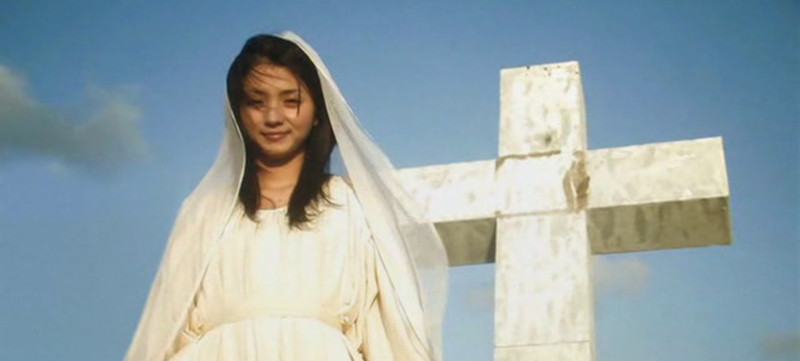5. Pulp Fiction (Quentin Tarantino, 1994)

One of the most universally loved and quoted films of all time; let us be honest, who hasn’t seen Quentin Tarantino’s 1994 Palme d’Or winner several times? Those who haven’t certainly belong to a minority.
Two years prior, an exciting new filmmaker emerged onto the American independent scene, premiering his feature-film debut Reservoir Dogs at the esteemed Sundance Film Festival to enormous praise. It was a heist film that didn’t exhibit the heist, and yet audiences didn’t care because of its superbly written and cool characters, something Pulp Fiction would remarkably manage to top.
To mention the plot would be redundant at this point – it is a tale of intersecting narratives, and while this was not something new in cinema, the way that Tarantino executed it surely was. Love it or hate it, Tarantino made an irremovable mark on cinema with his sophomore effort, an effort he is yet to top and unlikely ever will.
To say that the film is bursting with iconic moments would be an understatement; it may be the defining film of the 1990s, and it is genuinely surprising that some are yet to see it. Perhaps less surprising is that when first time audiences witness it they feel as if they’ve already seen it, and that’s because this film has become such a landmark of popular culture, referenced by almost everyone.
For some ridiculous reason there are a growing number of people who try to downplay their previously outspoken love for Pulp Fiction because they feel it has become too mainstream – a pop culture monster that they feel belongs to casual filmgoers rather than the knowledgeable cinephile.
Such an approach is pretentious, but it is becoming more apparent as the years go on. However, for most of us the film remains incredibly entertaining, with so many memorable moments and characters that made such an impression on us upon first viewing. Most can compare it to an old friend, and it’s a welcome reunion every time we return to it.
4. American Honey (Andrea Arnold, 2016)

English filmmaker Andrea Arnold proved she was a talent to keep an eye on with the release of her directorial feature-debut Red Road in 2006 – a decade later she was still impressing audiences, releasing her most ambitious film to date in 2016: American Honey.
Arnold scouted many locations to find the perfect unknown cast for her story of magazine-selling misfits on the open road, and luckily managed to find Sasha Lane and provide her with a breakout lead role.
Even next to such talent as the criminally underrated Shia LaBeouf, she absolutely shines in the role of Star, a young woman desperate to escape the perils of redneck America. Her journey is vast and informative, as the characters and audience are taken on a tour through an America that has failed the youth the film depicts. They are orphans of the US, and through their misfortune they have learnt a harsh lesson and utilised their knowledge to afford survival on the periphery of the societies they accustom themselves to.
Arnold’s social commentary is staggeringly precise, taking inspiration from the films of such directors as Larry Clark but refusing to narrow her focus. It is a film that enables its cast and crew to say so much about the environments they project, and in the wake of the film’s conclusion we feel utterly transformed by what we have both seen – becoming one and the same with the protagonist until her rebirth.
As well as excellent performances, cinematography and narrative progression, the soundtrack does well to replicate the youth culture it aims to understand, constantly subjected to rappers promoting a “money is power” ideology, trying to chase this dream any way they can.
Despite nearly pushing three hours in length it is a film that some have returned to many times since its release, and it has given them more and more each time. American Honey is a film that feels incredibly relevant, telling us so much about the complex relationship between rich and poor, and it is without a doubt the best film of 2016.
3. Stalker (Andrei Tarkovsky, 1979)

Although not the most prolific or varied, Russian maestro Andrei Tarkovsky is understood to have the most accomplished filmography; spanning seven cinematic works of art, it is almost impossible to disagree. To decide upon his greatest piece of work almost feels disrespectful – they are all so thoughtful – however, if hard pressed it would have to be his 1979 science-fiction masterpiece, Stalker.
Based on the Strugatsky Brothers’ novel Roadside Picnic, the film tells the story of Stalker, a man who guides customers through a quarantine zone which has been sanctioned off by the government restricting public access. It is said that the laws of nature do not apply in this space, and troubled souls have become fascinated by the mystery of the fabled “Room”, a place in which wishes are supposedly granted. Stalker takes Writer and Professor – addressed by their professions – through the Zone, helping them navigate the perilous deceptions of its landscape.
The film stands as a deeply philosophical and thought-provoking example of the greatness that can be achieved through exploring the science-fiction genre to its very limits. Tarkovsky’s images are poetic and mesmerising, and while every single one of his films belongs amongst the most gorgeous in cinema, Stalker is his most visually intoxicating. Every frame, every monologue and every direction it takes is testament to the man’s genius.
To quote the director himself: “Perhaps it was in Stalker that I felt for the first time the need to indicate clearly and unequivocally the supreme value by which, as they say, man lives.” In his aims, he was entirely successful, and regrettably, the press at the time of the film’s release were rather critical, to which Tarkovsky replied, “I am only interested in the views of two people: one is called Bresson and one called Bergman.” The latter of which even declared him the greatest director ever to have lived.
No matter how many times you rewatch and read about Stalker, it never feels enough – it is a film that will forever teach us about ourselves, and its beauty is something that audiences should never pass up, no matter how many times it has made them weep.
2. Magnolia (Paul Thomas Anderson, 1999)

How is it possible that American master Paul Thomas Anderson managed to write the bulk of his script for Magnolia in just two weeks? It all started with the character of Claudia, and it seems that the range of deeply flawed and recognisable characters followed from there. At the time of its release Anderson said that the film was the favourite of his own work, and it would be hard to imagine him changing his answer if asked today.
Heavily inspired by the work of Robert Altman – whose film Short Cuts was discussed in this piece – the film interweaves numerous stories that are linked in such resourceful and seamless ways. One of the reasons that Magnolia works so well is that every single character depicted could rightfully demand their own feature, but instead, they are all the protagonist of one sweeping and emotional journey, telling one single story; that of life.
Another reason is the masterful editing and camerawork, resulting in a three-hour film that gives the impression of constant mobility and movement, with every single shot imitating the most dramatic moments of reality. The acting is phenomenal, offering career-best performances from Tom Cruise, John C. Reilly and William H. Macy, and is worth rewatching simply to watch these actors shine like never before.
This cannot be said of many films, but Magnolia is genuinely a life-changing cinematic experience, and while many still attack the film’s ending, to declare it one of the most important American films of the century would be justified. It gets better with every viewing, and if it’s been a while since you’ve seen it, what are you waiting for?
1. Love Exposure (Sion Sono, 2008)

Sion Sono’s 2008 magnum-opus became infamous when it toured the film festival circuit for its lengthy runtime. The original cut was six hours, but the producers requested it to be trimmed; agreeing, Sono cut the film down to a four-hour and final cut, of which most of us saw and fell in love with.
Despite its excessive duration, Love Exposure never has us looking for the clock – the cult Japanese auteur created his own engrossing and insane world, and to spend four hours in it feels too brief for some, making it such a thrilling proposal to return to it as often as we can.
Sono tells the story of a Catholic priest’s son Yu (Takahiro Nishijima) who instantly falls in love with the troubled and cool Yoko (Hikari Mitsushima). She immediately falls for him, however, she believes him to be the female crime-boss Miss Scorpion. Caught in a dilemma, Yu must attempt to convince Yoko to love him for who he truly is, coming into complications of cults, brainwashing and heroism.
The film is celebratory of the madness and freedom that many of us associate and adore about Japanese film, and Sono has consistently proven that he has surpassed the likes of Takashi Miike to become the crowning ambassador for the nation’s cult cinema. He has made some tremendous films, such as The Whispering Star, Love and Peace, Strange Circus and Antiporno – yet, Love Exposure remains his most memorable and brilliant achievement. It is packed with so many unforgettable characters and sequences, injected with humour and heart up until its beautiful final moments.
It is a film which has quickly become beloved by many cinema lovers. Jaime Grijalba of Brooklyn Magazine summarised it best, saying that “It’s the most bombastic work of Japanese Cinema of the past decade and maybe the only four-hour film you can watch more than three times… in a year.” Call us crazy, but many of us do just that.